 June 25, 2021 Oroville Wildlife Area Habitat Project The sunflowers and safflowers planted this spring on 60 acres of the Oroville Wildlife Area (OWA) are growing taller. The nearly 12,000-acre OWA in Butte County is a popular stopping place on the Pacific Flyway for migrating and native birds. Managed by the California Department of Fish and Wildlife (CDFW) for the Department of Water Resources (DWR), the OWA also includes DWR’s Thermalito Afterbay reservoir, a prime habitat for migrating waterfowl and several endangered species. CDFW farms more than 300 acres of grains, grasses, and flowering plants in the OWA to provide food (forage), shelter, and nesting cover for migratory and native birds. Recently, 60 acres in various locations around the Thermalito Afterbay were planted with sunflowers and safflowers. Read more about CDFW’s 50 years of using dry-land farming techniques to add diversity to the area’s wildlife habitat on the DWR Updates webpage. DWR will be tracking the success of these 60 acres over the summer and photos can be found on DWR’s public photo sharing site by using the search term “Oroville Wildlife Area Planting”. Photo: Sunflowers grow in the Oroville Wildlife Area to provide forage and habitat for wildlife and birds. Drought Information California is no stranger to drought; it is a recurring feature of our climate. Lake Oroville’s low lake levels are a reminder of this cycle of dry and wet years. This year’s drought conditions are being felt across the western United States, with many areas, including California’s Central Valley, identified as being in “extreme drought” - the highest category of drought conditions. DWR has created a “Drought” webpage where definitions, historical trends, current information, and maps of California’s water systems can be found. Links to resources, DWR activities, research, and data are available. Read about how heatwaves are impacting drought conditions on the DWR Updates webpage. DWR is encouraging water conservation efforts by all Californians. Find out ways you can help by visiting the “Save Our Water” website. 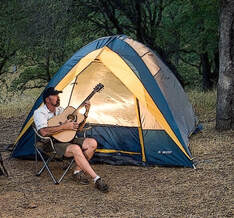 Oroville Recreation Bidwell Canyon Boat Ramp is currently open with future status dependent on lake levels. Boat ramp information can be obtained by calling the California Department of Parks and Recreation (CA Parks) at (530) 538-2200 or visiting the Lake Oroville State Recreation Area (LOSRA) website at www.parks.ca.gov/LakeOroville. Both the Lime Saddle and Bidwell Canyon marinas will remain open 8 a.m. until sundown. Visitors to the Thermalito North Forebay will find a full CA Parks facility with restrooms, picnic areas, a swim beach, and the Forebay Aquatic Center with kayaks, paddle boards, and other watercraft available for rent. The Monument Hill facility at the Thermalito Afterbay also provides boat ramp access, restrooms, a picnic area, and a swim beach. More than 97 miles of trails and numerous Day Use Area (DUA) facilities with picnic tables and restrooms at Lake Oroville State Recreation Area (LOSRA) are open 8 a.m. to sunset. Bidwell, Lime Saddle, and Loafer Creek Recreation Areas are open 24 hours. Summer access hours of 5 a.m. to 11 p.m. daily is now in effect for the Spillway Boat Ramp Area - gates close at 11 p.m. Vehicle access to Oroville Dam Crest Road across Oroville Dam is available 5 a.m. to 11 p.m. daily and open to pedestrians and bicyclists 24-hours a day. The Lake Oroville Visitor Center remains closed due to COVID-19 restrictions. Visit the California Parks LOSRA webpage for current information on facility status, campground reservations, and to find current requirements to protect public health during the COVID-19 pandemic. An interactive map of recreation facilities in DWR’s Oroville-Thermalito Complex is available on DWR’s Lake Oroville Recreation webpage. Information about the 11,000-acre Oroville Wildlife Area is available on the California Department of Fish and Wildlife webpage. Photo: Swim beach at North Forebay Recreation Area  Grazing Goats Reduce Fire Risk Hillsides along the Dan Beebe and Bidwell Canyon trails near Kelly Ridge look quite different after 1,600 goats and sheep from the Hanski Family Farms visited the area. The goat grazing project is part of DWR’s Fuel Load Management Plan, which helps reduce wildfire risk, increase public safety, and enhance forest health in areas around Lake Oroville within the Federal Energy Regulatory Commission (FERC) project boundary. In partnership with Butte County Fire Safe Council, DWR utilized grazing as a sustainable method of fuel reduction on about 35 acres to help minimize the risk or lessen the spread of a wildfire. To learn more and see goat grazing in action, visit DWR’s YouTube channel for a video of the March 2021 Lakeland Blvd. goat grazing project. Photo: Grazed and un-grazed hillsides near Kelly Ridge Current Lake Operations The elevation of Oroville’s reservoir is about 690 feet elevation and storage is about 1.18 million acre-feet -- 34 percent full and 41 percent of historical average. Currently, in the Northern Sierra Basin, snowpack is also below average at five percent of normal. An Excessive Heat Watch is in effect beginning this weekend (Saturday) through Wednesday in the Northern and Central Sacramento Valley. Temperatures are forecast to be over 100 degrees throughout the weekend and next week. Total flow to the Feather River is currently at 2,750 cubic feet per second (cfs) for meeting downstream water quality and flow requirements. Flow down the low flow channel, through the City of Oroville, is 2,150 cfs and flow through the Thermalito Afterbay Outlet is 600 cfs. Currently, these flow patterns will hold through the weekend. Plans to reduce flows in the low flow channel at a rate of 300 cfs per day to the Thermalito Afterbay Outlet will be scheduled until its desired level is reached. Current releases are re-assessed on a daily basis. The public can track precipitation, snow, reservoir levels, and more at the California Data Exchange Center at www.cdec.water.ca.gov. Lake Oroville is identified as “ORO”. All data as of midnight - 6/24/2021 ### Know someone who would like to receive Community Updates? They can email their request to [email protected]. 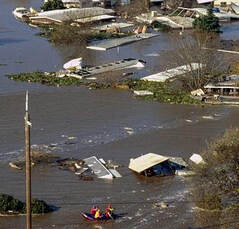 June 18, 2021 Drought Information California is no stranger to drought; it is a recurring feature of our climate. Lake Oroville’s low lake levels are a reminder of this cycle of dry and wet years. This year’s drought conditions are being felt across the western United States, with many areas, including California’s Central Valley, identified as being in “extreme drought” - the highest category of drought conditions. The Department of Water Resources (DWR) has created a “Drought” webpage where definitions, historical trends, current information, and maps of California’s water systems can be found. Links to resources, DWR activities, research, and data are available. DWR is encouraging water conservation efforts by all Californians. Find out ways you can help by visiting the “Save Our Water” website. Lake Oroville Boat Ramp Status Bidwell Canyon Boat Ramp is currently open with future status dependent on lake levels. Boat ramp information can be obtained by calling the CA Department of Parks and Recreation (CA Parks) at (530) 538-2200 or visiting the Lake Oroville State Recreation Area (LOSRA) website at www.parks.ca.gov/LakeOroville. Both the Lime Saddle and Bidwell Canyon marinas will remain open 8 a.m. until sundown. Oroville Recreation Visitors to the Thermalito North Forebay will find a full CA Parks facility with restrooms, picnic areas, a swim beach, and the Forebay Aquatic Center with kayaks, paddle boards, and other watercraft available for rent. The Monument Hill facility at the Thermalito Afterbay also provides boat ramp access, restrooms, picnic area, and a swim beach. More than 97 miles of trails and numerous Day Use Area (DUA) facilities with picnic tables and restrooms at Lake Oroville State Recreation Area (LOSRA) are open 8 a.m. to sunset. Bidwell, Lime Saddle, and Loafer Creek Recreation Areas are open 24 hours. Summer access hours of 5 a.m. to 11 p.m. daily is now in effect for the Spillway Boat Ramp Area - gates close at 11 p.m. Vehicle access to Oroville Dam Crest Road across Oroville Dam is available 5 a.m. to 11 p.m. daily. Exercise enthusiasts can log a round-trip of just over two miles while they enjoy the spectacular views from Oroville Dam Crest Road across the top of the dam, which is open to walkers, joggers, and bicyclists 24-hours a day. Surrounded by trails, the Thermalito Diversion Pool is open for kayaking and other non-motorized boating, trailered boats are not permitted at this location. The Feather River Fish Hatchery’s viewing area and fish ladder are open to the public. The Lake Oroville Visitor Center remains closed due to COVID-19 restrictions. Visit the California Parks LOSRA webpage for current information on facility status, campground reservations, and to find current requirements to protect public health during the COVID-19 pandemic. An interactive map of recreation facilities in DWR’s Oroville-Thermalito Complex is available on DWR’s Lake Oroville Recreation webpage. Information about the 11,000-acre Oroville Wildlife Area is available on the California Department of Fish and Wildlife webpage. Photo: Swim beach at North Forebay Recreation Area Thermalito Afterbay Outlet Work Divers have nearly completed work on the first stage of a 3-year project to increase the operational reliability of the Thermalito Afterbay Outlet radial gates. The gates of the Outlet have been closed this past week to allow divers to perform underwater work. The Outlet’s required flows to the Feather River were routed to the river’s Low Flow Channel that runs from the Thermalito Diversion Dam through Oroville. As work is completed, the gates will be reopened, allowing river flows through the Low Flow Channel to gradually decrease during the week of June 21 as flows from the Thermalito Afterbay Outlet are restored. River users are always advised to be aware of currents and colder water temperatures. 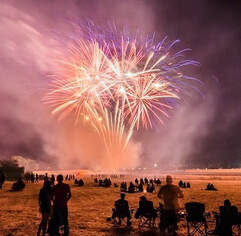 Grazing Goats Reduce Fire Risk Over 1,500 goats and sheep are busy eating their way through dried grasses and brush in the Kelly Ridge area and along the Dan Beebe and Bidwell Canyon trails. DWR staff overseeing the project report the goats are making great progress in reducing overgrown vegetation in the 34-acre target area. The goats started grazing June 13 at Arroyo Drive and are moving south towards the Saddle Dam area. DWR in partnership with Butte County Fire Safe Council, contracted with Hanski Family Farms in Paradise to utilize grazing as a sustainable method of fuel reduction to help minimize the risk or lessen the spread of a wildfire. The goats and sheep will graze on dried grasses, leaves, invasive and non-invasive plants including poison oak and star thistle, and a variety of shrubs and trees. By standing on their hind legs, goats can reduce ladder fuels (overgrown vegetation that allows fire to climb from the forest floor into the taller shrubs and into the tree canopy) up to four feet high. Higher branches are being removed and placed on the ground for further grazing in order to increase fire protection. The grazing area will be cordoned off with an electric fence and monitored by herdsmen and livestock guardian dogs to protect the animals. The public is urged to stay clear of the electric fence and keep pets away, so the goats are not disturbed. This work is part of DWR’s Fuel Load Management Plan which helps reduce wildfire risk, increase public safety, and enhance forest health in areas around Lake Oroville within the Federal Energy Regulatory Commission (FERC) project boundary. Approximately 34 acres will be grazed over the next couple weeks. To learn more and see goat grazing in action, visit DWR’s YouTube channel for a video of the March 2021 Lakeland Blvd. goat grazing project. Photo: Grazing goats feast on grass, shrubs and trees near Kelly Ridge 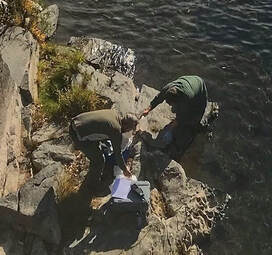 Blue Green Algae Monitoring DWR environmental scientists regularly monitor for blue-green algae and their toxins during the summer months. There are currently no harmful algal bloom (HAB) advisories for Lake Oroville, the Thermalito Forebay, or the Thermalito Afterbay. Blue-green algae (cyanobacteria) is a natural component of ecosystems. Under certain conditions, including warmer temperatures and increased nutrient loads, algae can grow rapidly causing “blooms.” Keep animals and children away from the water when a suspected harmful algal bloom (HAB) is present and report the possible HAB immediately. Water samples are taken at various locations regularly from Memorial Day through Labor Day and sent to a lab for toxin analysis. If elevated levels of cyanobacteria toxins are found while testing, DWR staff will work with California’s Regional Water Quality Control Board and recreation area managers to notify the public and post advisory signs at affected waterbodies. To learn more about HABs, or to report a HAB visit the Water Board’s website. Photo: Algal bloom on Lake Oroville's North Fork in June 2020 Current Lake Operations The elevation of Oroville’s reservoir is about 698 feet elevation and storage is about 1.24 million acre-feet -- 35 percent full and 43 percent of historical average. Currently, in the Northern Sierra Basin, snowpack is also below average at five percent of normal. Excess heat warnings are in effect until Saturday night. Temperatures are forecast to be in the 100s over the weekend, in the 90s during the week, then increasing to be above 100 over the following next weekend. Total flow to the Feather River is currently at 2,750 cfs for meeting downstream water quality and flow requirements. Due to work being performed at the Thermalito Afterbay River Outlet gates, all flow has been rerouted down the low flow channel, through the City of Oroville. Once the work is completed, flows will be rerouted at a rate of 300 cfs per day from the low flow channel to the Thermalito Afterbay Outlet until desired flows are reached. Current releases are re-assessed on a daily basis. The public can track precipitation, snow, reservoir levels, and more at the California Data Exchange Center at www.cdec.water.ca.gov. Lake Oroville is identified as “ORO”. All data as of midnight 6/17/2021 ### Know someone who would like to receive Community Updates? They can email their request to [email protected].  June 11, 2021 Thermalito Afterbay Outlet Work A project to increase the operational reliability of the Thermalito Afterbay Outlet radial gates will require closure of the gates to allow divers to perform underwater work. Required flows to the Feather River will be routed to the river’s Low Flow Channel that runs from the Thermalito Diversion Dam through Oroville beginning on June 11. Flows will gradually increase from 950 cubic feet per second (cfs) to 2,550 cfs by June 15 resulting in swift water and an increase in river height of about one foot from the Thermalito Diversion Dam down to the Thermalito Afterbay River Outlet. The gates will be closed until June 21 with river flows through the Low Flow Channel gradually decreasing the rest of that week as flows from the Thermalito Afterbay Outlet are restored. River users are always advised to be aware of currents and colder water temperatures. Lake Oroville Boat Ramp Status The Lime Saddle and Loafer Point boat ramps closed June 3. Although water may still cover the bottom of a boat ramp, there is not enough depth over the paved ramp to safely launch and trailer boats. Both the Lime Saddle and Bidwell Canyon marinas will remain open from 8 a.m. until sundown. The Spillway boat ramp will remain open for the weekend of June 12 to June 13 and is anticipated to close early next week. Bidwell Canyon is currently open with future status dependent on lake levels. Boat ramp information can be obtained by calling the CA Department of Parks and Recreation (CA Parks) at 530-538-2200 or visiting the Lake Oroville State Recreation Area (LOSRA) website at www.parks.ca.gov/LakeOroville. Grazing Goats Reduce Fire Risk Over 1,500 bleating goats mixed with sheep may be heard by trail users and Kelly Ridge residents beginning Sunday, June 13 in the Kelly Ridge area. Grazing efforts will start at the Saddle Dam Recreation Area, move north along the Dan Beebe and Bidwell Canyon trails, and will finish near the Bidwell Canyon recreation area at Arroyo Drive. DWR in partnership with Butte County Fire Safe Council, has contracted with Hanski Family Farms in Paradise to utilize grazing as a sustainable method of fuel reduction to help minimize the risk or lessen the spread of a wildfire. The goats and sheep will graze on dried grasses, leaves, invasive and non-invasive plants including poison oak and star thistle, and a variety of shrubs and trees. By standing on their hind legs, goats can reduce ladder fuels (overgrown vegetation that allows fire to climb from the forest floor into the taller shrubs and into the tree canopy) up to four feet high. The grazing area will be cordoned off with an electric fence and monitored by herdsmen and livestock guardian dogs to protect the animals. The public is urged to stay clear of the electric fence and keep pets away, so the goats are not disturbed. This work is part of DWR’s Fuel Load Management Plan which helps reduce wildfire risk, increase public safety, and enhance forest health in areas around Lake Oroville within the Federal Energy Regulatory Commission (FERC) project boundary. Approximately 34 acres will be grazed over the next couple weeks. To learn more and see goat grazing in action, visit DWR’s YouTube channel for a video of the March 2021 Lakeland Blvd. goat grazing project. Photo: Grazing goats feast on shrubs and trees at Lakeland Blvd. in April 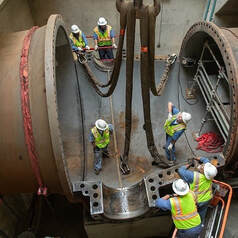 Oroville Recreation More than 97 miles of trails and numerous Day Use Area (DUA) facilities with picnic tables and restrooms at Lake Oroville State Recreation Area (LOSRA) are open 8 a.m. to sunset. Bidwell, Lime Saddle, and Loafer Creek recreation areas are open 24 hours. Summer access hours of 5 a.m. to 11 p.m. daily is now in effect for the Spillway Boat Ramp Area - gates close at 11 p.m. Vehicle access to Oroville Dam Crest Road across Oroville Dam is available 5 a.m. to 11 p.m. daily. Exercise enthusiasts can log a round-trip of just over two miles while they enjoy the spectacular views from Oroville Dam Crest Road across the top of the dam, which is open to walkers, joggers, and bicyclists 24-hours a day. Surrounded by trails, the Thermalito Diversion Pool is open for kayaking and other non-motorized boating. Visitors to the Thermalito North Forebay will find a full CA Parks facility with restrooms, picnic areas, a swim beach, and the Forebay Aquatic Center with kayaks, paddle boards, and other watercraft available for rent. The Monument Hill facility at the Thermalito Afterbay also provides boat ramp access, restrooms, picnic area, and a swim beach. The Feather River Fish Hatchery’s viewing area and fish ladder are open to the public. The Lake Oroville Visitor Center remains closed due to COVID-19 restrictions. Visit the California Parks LOSRA webpage for current information on facility status, campground reservations, and to find current requirements to protect public health during the COVID-19 pandemic. An interactive map of recreation facilities in DWR’s Oroville-Thermalito Complex is available on DWR’s Lake Oroville Recreation webpage. Information about the 11,000-acre Oroville Wildlife Area is available on the California Department of Fish and Wildlife webpage. Photo: Hiking on trails near Thermalito Forebay  Thermalito Forebay Control Burn Successful A series of vegetation management control burns around the Thermalito Forebay was conducted by CAL FIRE/Butte County Fire Department on June 3 in cooperation with the Department of Water Resources (DWR) and CA Parks. A total of about 245 acres was successfully treated. The vegetation management control burns have multiple beneficial impacts grasslands around the Thermalito Forebay, including seasonal wetlands called vernal pools. Although vernal pools are only a small component of these grasslands, they support a high diversity of California native plants and animals, including rare and endangered species and species endemic to California (i.e., found nowhere else in the world). Fire from carefully controlled burns is the most powerful tool to combat invasive plants and dry invasive grass buildup called ‘thatch’ within these grasslands and vernal pools. The burns will also remove dangerous fire fuels from grassland adjacent to private property and near high-use areas. Photo: Control burn removes invasive plants and grasses near vernal pool area.  Blue Green Algae Monitoring DWR environmental scientists regularly monitor for blue-green algae and their toxins during the summer months. There are currently no harmful algal blooms (HAB) advisories for Lake Oroville, the Thermalito Forebay, or the Thermalito Afterbay. Water samples are taken at various locations regularly from Memorial Day through Labor Day and sent to a lab for toxin analysis. Blue-green algae (cyanobacteria) is a natural component of ecosystems. Under certain conditions, including warmer temperatures and increased nutrient loads, algae can grow rapidly causing “blooms.” Algal blooms sometimes produce toxins that can be harmful to people and animals. Keep animals and children away from the water when a suspected harmful algal bloom (HAB) is present and report the possible HAB immediately. If elevated levels of cyanobacteria toxins are found, DWR staff will work with California’s Regional Water Quality Control Board and recreation area managers to notify the public and post advisory signs at affected waterbodies. To learn more about HABs or to report a HAB visit the Water Board’s website. Photo: Algal bloom on Lake Oroville's West Branch in August 2020 Current Lake Operations The elevation of Oroville’s reservoir is about 703 feet elevation and storage is about 1.28 million acre-feet -- 36 percent full and 43 percent of historical average. Currently, in the Northern Sierra Basin, snowpack is also below average at five percent of normal. Temperatures are forecast to be in the mid- to high-90s over the weekend increasing to near or above 100 towards the end of the week. On Monday, June 7, 2021, total flows to the Feather River were increased from 2,050 cfs to 2,550 cfs for downstream water quality and flow requirements. At this rate, flows down the low flow channel, through the City of Oroville are at 950 cfs and 1,600 cfs is being released from the Thermalito Afterbay Outlet (Outlet). Due to work at the Outlet, flows down the low flow channel will gradually increase to 2,550 beginning on June 11, reach 2,550 on June 15, and continue through June 21. Current releases are for meeting downstream water quality and flow requirements and are re-assessed on a daily basis. The public can track precipitation, snow, reservoir levels, and more at the California Data Exchange Center at www.cdec.water.ca.gov. Lake Oroville is identified as “ORO”. All data as of midnight 6/10/2021 ### Know someone who would like to receive Community Updates? They can email their request to [email protected].  May 28, 2021 Oroville Recreation Visitors to Lake Oroville for the Memorial Day holiday will find the Lime Saddle, Bidwell Canyon Stage III, Spillway, and the newly opened Loafer Point Stage II boat ramps open for use. Although currently at just under half of the historical water storage average for this time of year, Lake Oroville still provides nearly 7,000 acres of water surface for fishing, water sports, and recreation. More than 97 miles of trails and numerous Day Use Area (DUA) facilities with picnic tables and restrooms at Lake Oroville State Recreation Area (LOSRA) are open 8 a.m. to sunset. Bidwell, Lime Saddle, and Loafer Creek recreation areas are open 24 hours. Summer access hours of 5 a.m. to 11 p.m. daily is now in effect for the Spillway Boat Ramp Area - gates close at 11 p.m. Vehicle access to Oroville Dam Crest Road across Oroville Dam is available 5 a.m. to 11 p.m. daily. Exercise enthusiasts can log a round-trip of just over two miles while they enjoy the spectacular views from Oroville Dam Crest Road across the top of the dam, which is open to walkers, joggers, and bicyclists 24-hours a day. Visitors can also go to the Thermalito North Forebay’s Forebay Aquatic Center to rent kayaks and paddle boards. Sandy beaches are available at North Forebay and the Thermalito Afterbay’s Monument Hill. Reservations for LOSRA campgrounds are available on the California Department of Parks and Recreation (CA Parks) website, including reservations for the Lake’s floating campgrounds. Lime Saddle group camping remains closed. The Lake Oroville Visitor Center remains closed due to COVID-19 restrictions. Visit the California Parks LOSRA webpage for current information on facility status, campground reservations, and to find current requirements to protect public health during the COVID-19 pandemic. Information can also be found on the Lake Oroville Recreation webpage and the California Department of Fish and Wildlife webpage. Photo: Enjoying the water at Lake Oroville Oroville Dam Citizens Advisory Commission Public Meeting The California Natural Resources Agency held its seventh Oroville Dam Citizens Advisory Commission (OCAC) meeting on Friday, May 28. The online public meeting included an update on dam safety and presentations on risk assessment. Members of the public also asked questions and gained information on these and other topics. The Citizens Advisory Commission is a forum for the community to provide feedback and ask questions. The meeting transcript and presentations will be available on the Commission’s website in the coming weeks. CAL FIRE Controlled Burn Planned at Thermalito Forebay In cooperation with the Department of Water Resources (DWR) and CA Parks, CAL FIRE/Butte County Fire Department plans to conduct a series of vegetation management (VMP) burns around the Thermalito Forebay during the first week of June, dependent on forecast weather conditions and fire personnel activity. The burns will be in areas near the Forebay Aquatic Center, Nelson Sports Complex, South Forebay near Grand Avenue, and near Wilbur Road and Tres Vias Road. The VMP controlled burns have multiple beneficial impacts for the natural environment and public safety. The targeted grasslands are home to many vernal pools that support a high diversity of plants and animals, including rare and endangered species and species endemic to California (i.e., found nowhere else in the world). Fire from carefully controlled burns is the most powerful tool to combat invasive plants and their seeds such as dry invasive grass buildup called ‘thatch’ and invasive plants such as star thistle. Removal of invasive species allows native plants and animal species, such as fairy shrimp, to thrive. The burns will also remove dangerous fire fuels from grassland adjacent to private property and near high-use areas. Up to 250 acres are targeted for burning. 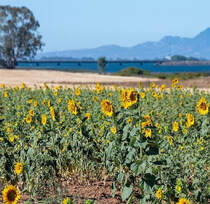 More Than 65 Acres Treated Around Lake Oroville This Season Fuel reduction work around Oroville continues to improve forest health and reduce fire risk. In partnership with Butte County Fire Safe Council, Butte County Sheriff’s Office (BCSO), the California Conservation Corps (CCC), CA State Parks, and CAL FIRE, DWR’s Fuel Load Management Plan (FLMP) work has thinned approximately 25 acres of overgrown vegetation and trees, as well as cut, piled, and chipped approximately 40 acres of dead and dying hazardous fuels (trees and vegetation) from the North Complex wildfire burn scar at Loafer Creek. CAL FIRE and CCC crews are continuing to work within the North Complex wildfire burn scar using heavy equipment and hand crews to cut, pile, and chip burnt vegetation and trees. The piles will be burned this fall when conditions are safe for burning. BCSO crews are continuing to chip cut vegetation near the Equestrian Camp at Loafer Creek. Green Mountain Contractors, Inc. just completed a 13-acre thinning and chipping project along Highway 162 and the entrance to Loafer Creek Recreation area. FLMP efforts will be winding down as hotter and drier conditions elevate risk of accidental ignitions. Photo: CA Conservation Corps crew clearing North Complex wildfire burn scar at Loafer Creek  Blue Green Algae Monitoring DWR environmental scientists regularly monitor for blue-green algae and their toxins during the summer months. There are currently no HAB advisories for Lake Oroville, Upper Feather River lakes, the Thermalito Forebay, or the Thermalito Afterbay. Water samples are taken at various locations regularly from Memorial Day through Labor Day and sent to a lab for toxin analysis. Blue-green algae (cyanobacteria) is a natural component of ecosystems. Under certain conditions, including warmer temperatures and increased nutrient loads, algae can grow rapidly causing “blooms.” Algal blooms sometimes produce toxins that can be harmful to people and animals. Algal blooms can make the water appear green, blue, or brown in color. Seeing colors, mats, foam, scum, or paint-like streaks in the water may indicate a bloom is present. Keep animals and children away from the water when a suspected harmful algal bloom (HAB) is present and report the possible HAB immediately. If elevated levels of cyanobacteria toxins are found, DWR staff will work with California’s Regional Water Quality Control Board and recreation area managers to notify the public and post advisory signs at affected waterbodies. To learn more about HABs or to report a HAB visit the Water Board’s website. Photo: Algal bloom on Lake Oroville's West Branch in August 2020 Current Lake Operations The elevation of Oroville’s reservoir is about 713 feet elevation and storage is about 1.36 million acre-feet -- 39 percent full and 46 percent of historical average. Currently, in the Northern Sierra Basin, rainfall is below average, at 47 percent of normal for this time of year and snowpack is also below average at four percent of normal. An excessive heat watch is in effect from Sunday afternoon through Tuesday evening with temperatures well above 100 degrees. Expect temperatures to remain in the upper 90s low 100s through the remainder of the week. Currently, flows down the low flow channel through the City of Oroville are at 650 cfs and 1,850 cfs is being released from the Thermalito Afterbay Outlet (Outlet) for a total of 2,500 cfs downstream of the Outlet. Current releases are for meeting downstream water quality and flow requirements and are re-assessed on a daily basis. The public can track precipitation, snow, reservoir levels, and more at the California Data Exchange Center at www.cdec.water.ca.gov. Lake Oroville is identified as “ORO”. All data as of midnight 5/27/2021 ### Know someone who would like to receive Community Updates? They can email their request to [email protected]. |
Archives
October 2023
Categories
All
|

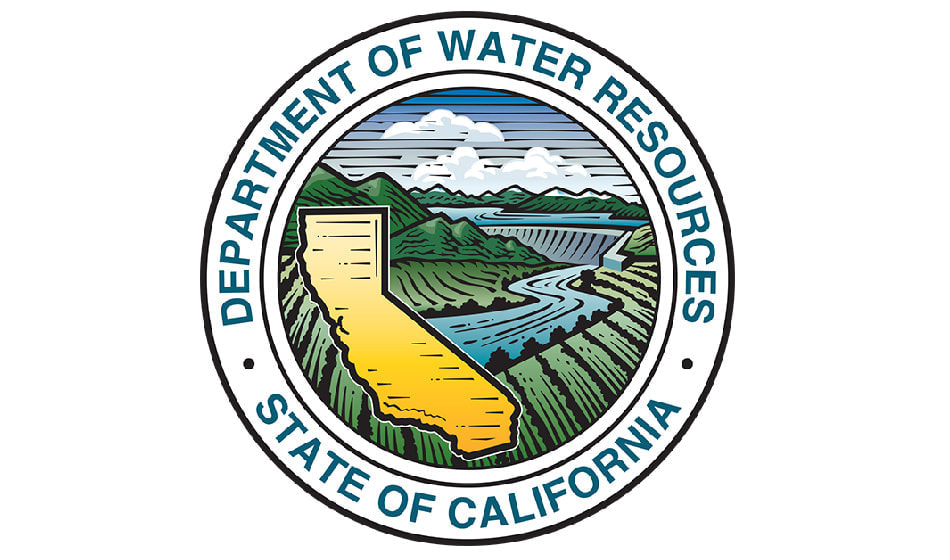
 RSS Feed
RSS Feed